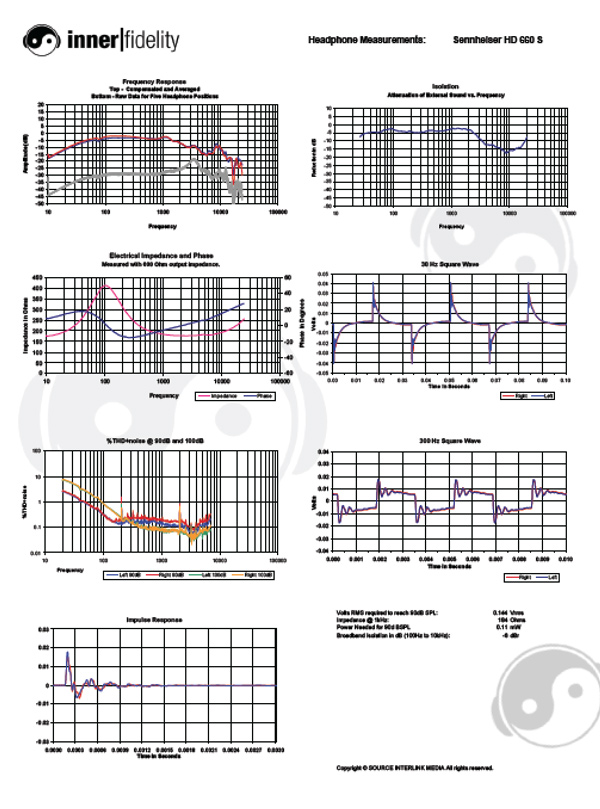| Columns Retired Columns & Blogs |
Sennheiser HD 660 S Over-Ear Open Headphones Measurements
Measurements


Click on graphs image to download .pdf for closer inspection.
I'll be doing some comparisons with the older siblings, so will offer you links to the HD 600 and HD 650 measurements.
Raw frequency response plots for the three headphones show the HD 660 S is essentially flat from 100Hz to 900Hz while the other two headphones are gently humped below about 400Hz. You can also see that the HD 660 S response begins to rise more quickly to the 3.3kHz peak at about 900Hz while the other two are more scooped on the rise. I feel this tonal profile causes the HD 660 S to be less "veiled" sounding and a bit more forward, but the flat lower-mid/upper-bass profile with the drop off below 100Hz makes the HD 660 S sound a bit leaner.
Above the 3.3kHz peak the three are quite similar, but the HD 660 S does seem to have a bit more energy 10kHz to 14kHz.
All three have fairly sway-backed 30Hz square wave response, which mostly represents the lack of bass extension below 100Hz.
The 300Hz square wave response is pretty telling. Leading edges are similar in shape, but the overall waveform top is flattest on the 650; the 600 is very slightly tilted indicating it's a bit leaner than the 650; and the 660 S is substantially more tilted showing it as the leanest of the three.
Also, after the initial ringing, there is some noise on the HD 660 S while the other two are essentially noiseless in this area. Close inspection of the impulse response shows this as well, though the 650 impulse response has more amplitude making harder to see. I think this is potentially evidence of the grainy sound I heard that masks fine detail and makes the 660 S less smooth sounding.
Better evidence for this graininess can be seen in Hands -45dB CSD plots in this post. In fact those interested in measurements should check out the entire "Sennheiser HD600 HD650 HD660S Analysis" thread on SBAF. Truly great work!
THD+noise plots are quite similar between these cans. All have pretty significant distortion in the bass.
Impedance plots show a nominally 150 Ohm headphone with a large primary driver resonance at 100Hz where impedance rises to 400Hz. Some extra bass might be available with very high output impedance tube amps. I didn't hear any with my Bottlehead Crack, but some amps might.
Isolation plots are typical for an open acoustic headphone. (I have to add here that my isolation measurements seem to be wandering in level a bit of late. Not sure what's going on but am looking into it.)
- Log in or register to post comments




































